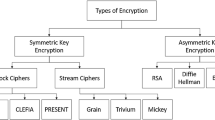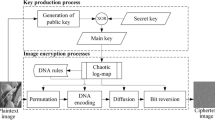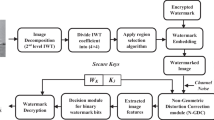Abstract
A new meaningful image encryption algorithm based on compressive sensing (CS) and integer wavelet transformation (IWT) is proposed in this study. First of all, the initial values of chaotic system are encrypted by RSA algorithm, and then they are open as public keys. To make the chaotic sequence more random, a mathematical model is constructed to improve the random performance. Then, the plain image is compressed and encrypted to obtain the secret image. Secondly, the secret image is inserted with numbers zero to extend its size same to the plain image. After applying IWT to the carrier image and discrete wavelet transformation (DWT) to the inserted image, the secret image is embedded into the carrier image. Finally, a meaningful carrier image embedded with secret plain image can be obtained by inverse IWT. Here, the measurement matrix is built by both chaotic system and Hadamard matrix, which not only retains the characteristics of Hadamard matrix, but also has the property of control and synchronization of chaotic system. Especially, information entropy of the plain image is employed to produce the initial conditions of chaotic system. As a result, the proposed algorithm can resist known-plaintext attack (KPA) and chosen-plaintext attack (CPA). By the help of asymmetric cipher algorithm RSA, no extra transmission is needed in the communication. Experimental simulations show that the normalized correlation (NC) values between the host image and the cipher image are high. That is to say, the proposed encryption algorithm is imperceptible and has good hiding effect.
Similar content being viewed by others
References
Tang Z, Zhang X. Secure image encryption without size limitation using Arnold transform and random strategies. Journal of Multimedia, 2011, 6(2): 202–206
Chen G, Mao Y, Chui C K. A symmetric image encryption scheme based on 3D chaotic cat maps. Chaos, Solitons & Fractals, 2004, 21(3): 749–761
Chen Y Q, Sun W J, Li L Y, Chang C C, Wang X. An efficient general data hiding scheme based on image interpolation. Journal of Information Security and Applications, 2020, 54: 102584
Zhang Y, Zhou J, Chen F, Zhang L Y, Wong K W, He X, Xiao D. Embedding cryptographic features in compressive sensing. Neurocomputing, 2016, 205: 472–480
Cheng G, Wang C, Xu C. A novel hyper-chaotic image encryption scheme based on quantum genetic algorithm and compressive sensing. Multimedia Tools and Applications, 2020, 79(39–40): 29243–29263
Song J, Lee Y H. Optical image encryption using different twiddle factors in the butterfly algorithm of fast Fourier transform. Optics Communications, 2021, 485: 126707
Ye G, Jiao K, Huang X. Quantum logistic image encryption algorithm based on SHA-3 and RSA. Nonlinear Dynamics, 2021, 104(3): 2807–2827
Wang X Y, Zhang Y Q, Bao X M. A novel chaotic image encryption scheme using DNA sequence operations. Optics and Lasers in Engineering, 2015, 73: 53–61
Ye G, Pan C, Dong Y, Shi Y, Huang X. Image encryption and hiding algorithm based on compressive sensing and random numbers insertion. Signal Processing, 2020, 172: 107563
Liao X, Li K, Zhu X, Liu K J R. Robust detection of image operator chain with two-stream convolutional neural network. IEEE Journal of Selected Topics in Signal Processing, 2020, 14(5): 955–968
Bao L, Zhou Y. Image encryption: generating visually meaningful encrypted images. Information Sciences, 2015, 324: 197–207
Ye G, Pan C, Dong Y, Jiao K, Huang X. A novel multi-image visually meaningful encryption algorithm based on compressive sensing and Schur decomposition. Transactions on Emerging Telecommunications Technologies, 2021, 32(2): e4071
Hua Z, Zhang K, Li Y, Zhou Y. Visually secure image encryption using adaptive-thresholding sparsification and parallel compressive sensing. Signal Processing, 2021, 183: 107998
Yang Y G, Wang B P, Yang Y L, Zhou Y H, Shi W M, Liao X. Visually meaningful image encryption based on universal embedding model. Information Sciences, 2021, 562: 304–324
Wen W, Hong Y, Fang Y, Li M, Li M. A visually secure image encryption scheme based on semi-tensor product compressed sensing. Signal Processing, 2020, 173: 107580
Yang Y G, Wang B P, Yang Y L, Zhou Y H, Shi W M. Dual embedding model: a new framework for visually meaningful image encryption. Multimedia Tools and Applications, 2021, 80(6): 9055–9074
Liao X, Yin J, Chen M, Qin Z. Adaptive payload distribution in multiple images steganography based on image texture features. IEEE Transactions on Dependable and Secure Computing, 2020
Liao X, Yu Y, Li B, Li Z, Qin Z. A new payload partition strategy in color image steganography. IEEE Transactions on Circuits and Systems for Video Technology, 2020, 30(3): 685–696
Kumar R, Chand S, Singh S. A reversible data hiding scheme using pixel location. International Arab Journal of Information Technology, 2018, 15(4): 763–768
Kumar R, Chand S, Singh S. A reversible high capacity data hiding scheme using combinatorial strategy. International Journal of Multimedia Intelligence and Security, 2018, 3(2): 146–161
Malik A, Singh S, Kumar R. Recovery based high capacity reversible data hiding scheme using even-odd embedding. Multimedia Tools and Applications, 2018, 77(12): 15803–15827
Kaur G, Singh S, Rani R, Kumar R, Malik A. High-quality reversible data hiding scheme using sorting and enhanced pairwise PEE. IET Image Processing, 2021
Kumar R, Chand S, Singh S. An improved Histogram-Shifting-Imitated reversible data hiding based on HVS characteristics. Multimedia Tools and Applications, 2018, 77(11): 13445–12457
Cun Q, Tong X, Wang Z, Zhang M. Selective image encryption method based on dynamic DNA coding and new chaotic map. Optik, 2021, 243: 167286
Gao X. Image encryption algorithm based on 2D hyperchaotic map. Optics & Laser Technology, 2021, 142: 107252
Zheng J, Hu H. A symmetric image encryption scheme based on hybrid analog-digital chaotic system and parameter selection mechanism. Multimedia Tools and Applications, 2021, 80(14): 20883–20905
Wang X, Chen X. An image encryption algorithm based on dynamic row scrambling and Zigzag transformation. Chaos, Solitons & Fractals, 2021, 147: 110962
Zheng J, Liu L. Novel image encryption by combining dynamic DNA sequence encryption and the improved 2D logistic sine map. IET Image Processing, 2020, 14(11): 2310–2320
Patro K A K, Soni A, Netam P K, Acharya B. Multiple grayscale image encryption using cross-coupled chaotic maps. Journal of Information Security and Applications, 2020, 52: 102470
Wu C, Hu K Y, Wang Y, Wang J, Wang Q H. Scalable asymmetric image encryption based on phase-truncation in cylindrical diffraction domain. Optics Communications, 2019, 448: 26–32
Guleria V, Sabir S, Mishra D C. Security of multiple RGB images by RSA cryptosystem combined with FrDCT and Arnold transform. Journal of Information Security and Applications, 2020, 54: 102524
Benssalah M, Rhaskali Y, Drouiche K. An efficient image encryption scheme for TMIS based on elliptic curve integrated encryption and linear cryptography. Multimedia Tools and Applications, 2021, 80(2): 2081–2107
Rakheja P, Singh P, Vig R. An asymmetric image encryption mechanism using QR decomposition in hybrid multi-resolution wavelet domain. Optics and Lasers in Engineering, 2020, 134: 106177
Wu H, Zhu H, Ye G. Public key image encryption algorithm based on pixel information and random number insertion. Physica Scripta, 2021, 96(10): 105202
Kumari E, Mukherjee S, Singh P, Kumar R. Asymmetric color image encryption and compression based on discrete cosine transform in Fresnel domain. Results in Optics, 2020, 1: 100005
Xu Q, Sun K, Cao C, Zhu C. A fast image encryption algorithm based on compressive sensing and hyperchaotic map. Optics and Lasers in Engineering, 2019, 121: 203–214
Chai X, Bi J, Gan Z, Liu X, Zhang Y, Chen Y. Color image compression and encryption scheme based on compressive sensing and double random encryption strategy. Signal Processing, 2020, 176: 107684
Wang H, Xiao D, Li M, Xiang Y, Li X. A visually secure image encryption scheme based on parallel compressive sensing. Signal Processing, 2019, 155: 218–232
Wang X, Su Y. Image encryption based on compressed sensing and DNA encoding. Signal Processing: Image Communication, 2021, 95: 116246
Liang Y R, Xiao Z Y. Image encryption algorithm based on compressive sensing and fractional DCT via polynomial interpolation. International Journal of Automation and Computing, 2020, 17(2): 292–304
Kumar D, Joshi A B, Mishra V N. Optical and digital double color-image encryption algorithm using 3D chaotic map and 2D-multiple parameter fractional discrete cosine transform. Results in Optics, 2020, 1: 100031
Kanso A, Ghebleh M. An algorithm for encryption of secret images into meaningful images. Optics and Lasers in Engineering, 2017, 90: 196–208
Chai X, Wu H, Gan Z, Zhang Y, Chen Y, Nixon K W. An efficient visually meaningful image compression and encryption scheme based on compressive sensing and dynamic LSB embedding. Optics and Lasers in Engineering, 2020, 124: 105837
Thanki R, Borra S, Dwivedi V, Borisagar K. A steganographic approach for secure communication of medical images based on the DCT-SVD and the compressed sensing (CS) theory. The Imaging Science Journal, 2017, 65(8): 457–467
Chai X, Gan Z, Chen Y, Zhang Y. A visually secure image encryption scheme based on compressive sensing. Signal Processing, 2017, 134: 35–51
Acknowledgements
The authors would like to thank sincerely the Editor and the anonymous Reviewers for their helpful comments and suggestions. This work was supported in part by the National Natural Science Foundation of China (Grant Nos. 61972103, 61772371, 62172301), the Natural Science Foundation of Guangdong Province of China (2019A1515011361), the Fundamental Research Funds for the Central Universities of China (22120210545), the Key Scientific Research Project of Education Department of Guangdong Province of China (2020ZDZX3064), and the Postgraduate Education Innovation Project of Guangdong Ocean University of China (202143).
Author information
Authors and Affiliations
Corresponding author
Additional information
Xiaoling Huang received the Master degree in Mathematics in June 2008 at Shantou University, China, and then joined in Guangdong Ocean University, China. She is currently an Associate Professor in Faculty of Mathematics and Computer Science at Guangdong Ocean University, China. The interesting areas are mathematical model, nonlinear analysis, cryptography, Image processing, and information security.
Youxia Dong received the Bachelor degree from Anhui University of Science and Technology, China, and then joined in Guangdong Ocean University, China. She is currently pursuing the Master degree of Computer Science and Technology at Guangdong Ocean University, China. The interesting areas are cryptography, image encryption, and information security.
Guodong Ye received the PhD degree in department of Electronic Engineering at City University of Hong Kong, China. From 2016 to 2018, He did the Post-doctoral research at Zhejiang University, China. At present, Dr. Ye is a Professor in Faculty of Mathematics and Computer Science at Guangdong Ocean University, China. His areas of interests are cryptography, application of chaotic system, compressive sensing, reversible information hiding, image encryption, etc.
Yang Shi is a Professor at the School of Software Engineering in Tongji University, China. He received the PhD degree from Tongji University, China in 2005. His research interests include cryptography, privacy computing, blockchain technology, information security, and software protection. Dr. Shi has published a number of refereed papers in top journals and conferences, including IEEE TC, IEEE TII, IEEE TETC, IEEE T-CE, etc.
Electronic supplementary material
Rights and permissions
About this article
Cite this article
Huang, X., Dong, Y., Ye, G. et al. Meaningful image encryption algorithm based on compressive sensing and integer wavelet transform. Front. Comput. Sci. 17, 173804 (2023). https://doi.org/10.1007/s11704-022-1419-8
Received:
Accepted:
Published:
DOI: https://doi.org/10.1007/s11704-022-1419-8




